Abstract
BACKGROUND: The aim of this study was to determine the relation between the severity of abnormalities in ventilatory function tests and tidal breathing pattern and gas exchange indices in interstitial lung disease. METHODS: Pulmonary function, ventilation, carbon dioxide production, oxygen consumption, arterial blood gas tensions, and pH were measured during resting steady state conditions in 60 patients with proved interstitial lung disease. Patients were categorised by forced vital capacity (FVC) (percentage of predicted values) as having a mild, moderate, or severe restrictive defect with means (SD) of 71% (4%), 57% (4%), and 41% (7%) of predicted values, respectively. RESULTS: FVC varied from 29% to 79% of predicted values and from 0.99 l to 4.32 l. The two measurements of FVC correlated strongly with most static lung volumes and with transfer factor for carbon monoxide. Mean respiratory rates (per minute) and tidal volumes (ml) were 17 (4) and 484 (131), 20 (4) and 460 (139), and 23 (5) and 377 (109) in mild, moderate, and severe restrictive defects, respectively. FVC correlated negatively with respiratory rate and positively with tidal volume. Arterial carbon dioxide tension ranged from 30 to 49 mm Hg; only two patients were hypercapnic. Mean arterial oxygen tensions were not significantly different among the three groups, and there were no significant correlations between forced expiratory volume in one second or FVC and arterial carbon dioxide tension or carbon dioxide production. CONCLUSION: Low values of FVC were associated with increased respiratory rate and decreased tidal volume; this pattern of breathing mimics external elastic loading, suggesting that mechanoreceptors may contribute to the rapid and shallow pattern of breathing in interstitial lung disease. Hypercapnia seems to be rare in interstitial lung disease even when functional impairment is severe and tidal volume is small. The increased respiratory rate is important in maintaining adequate ventilation. In the face of a severe restrictive defect carbon dioxide production did not increase, which also contributed to the maintenance of eucapnia.
Full text
PDF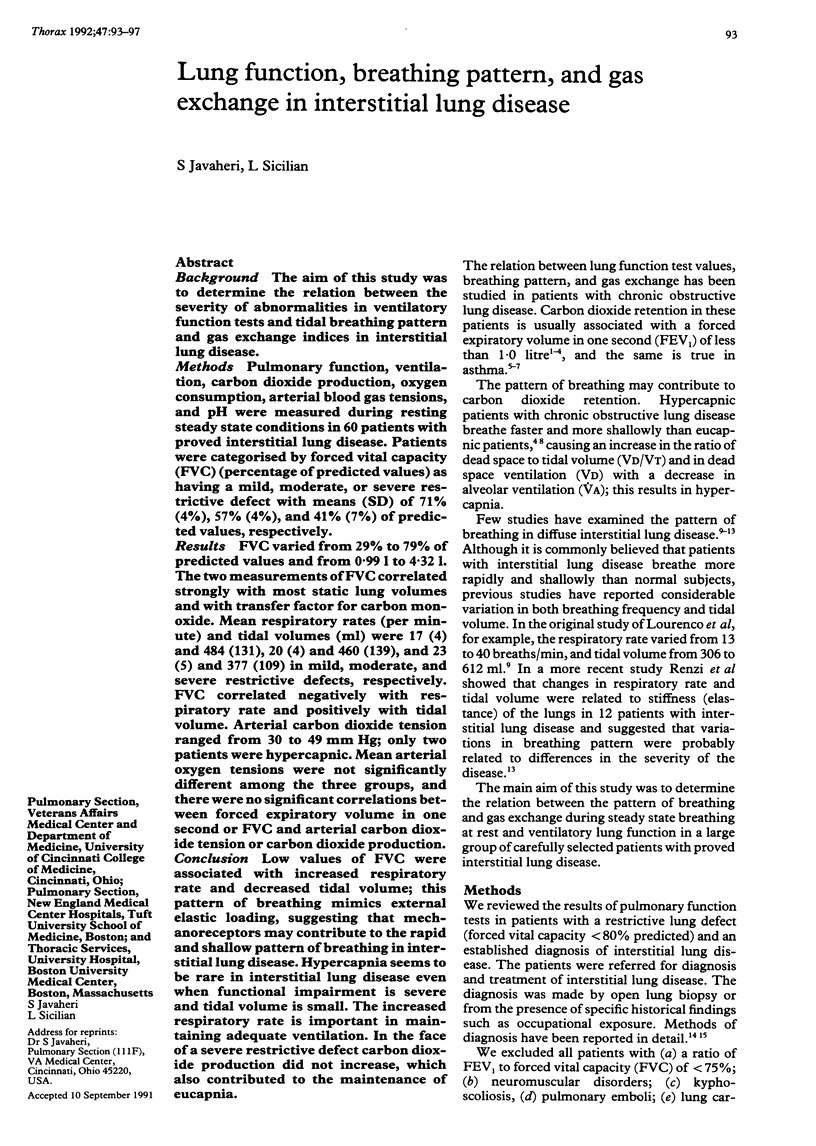
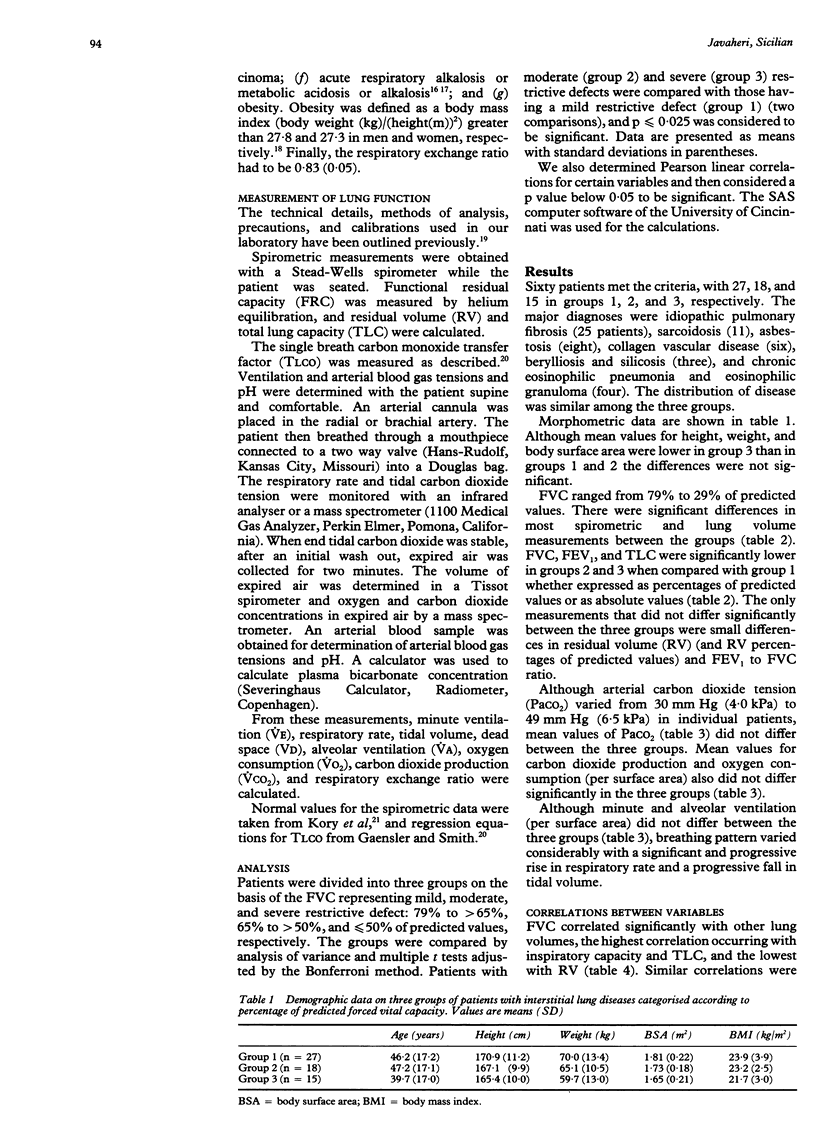
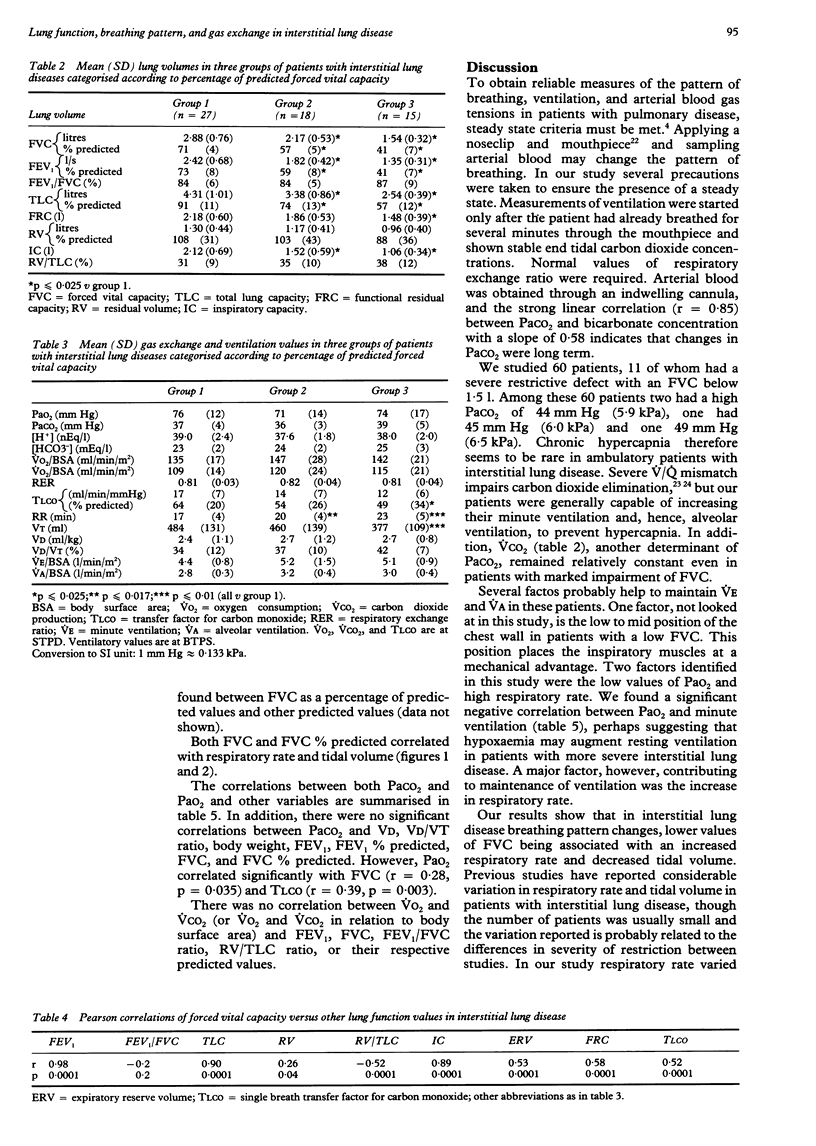
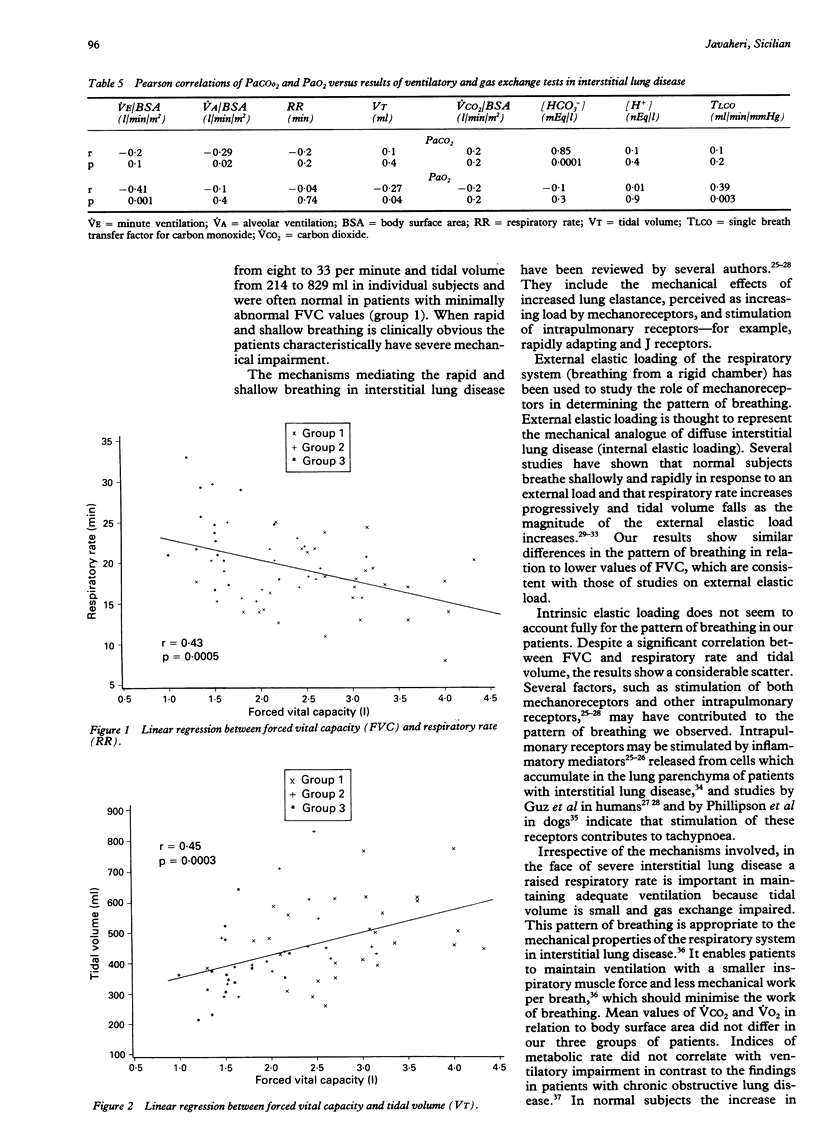
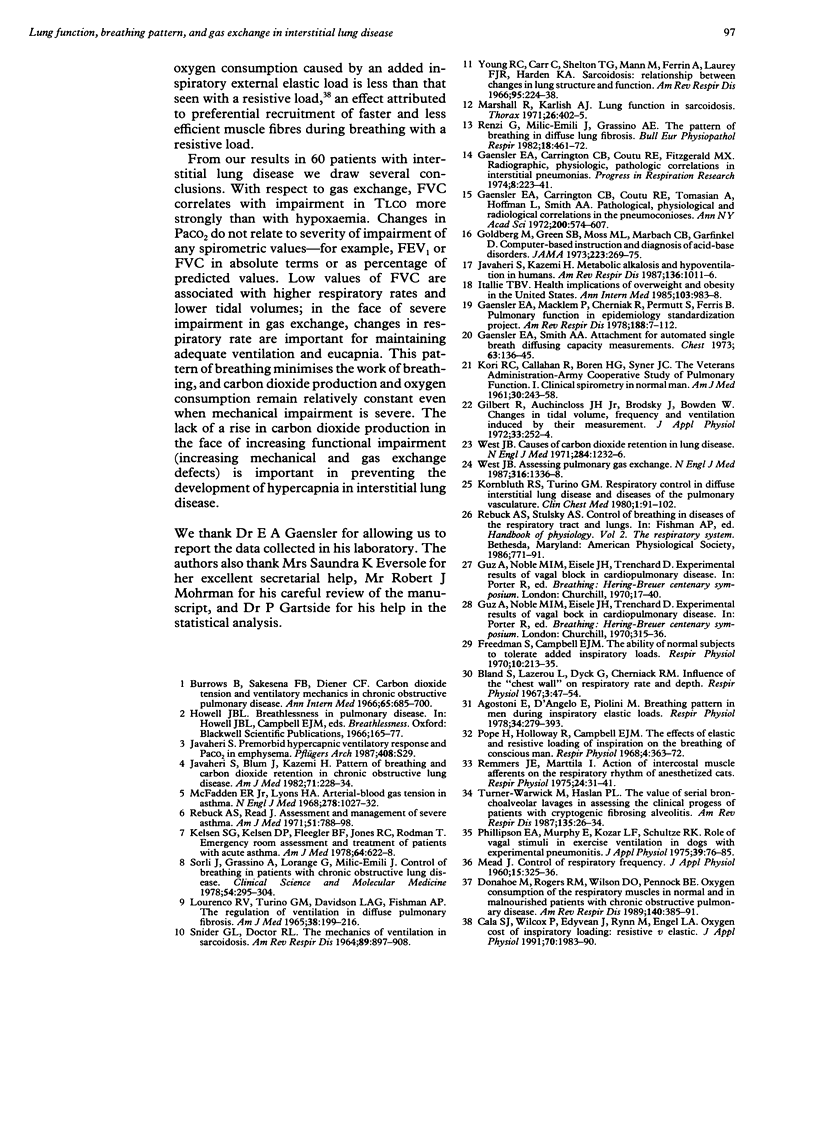
Selected References
These references are in PubMed. This may not be the complete list of references from this article.
- Agostoni E., D'Angelo E., Piolini M. Breathing pattern in men during inspiratory elastic loads. Respir Physiol. 1978 Aug;34(2):279–293. doi: 10.1016/0034-5687(78)90034-8. [DOI] [PubMed] [Google Scholar]
- Bland S., Lazerou L., Dyck G., Cherniack R. M. The influence of the "chest wall" on respiratory rate and depth. Respir Physiol. 1967 Aug;3(1):47–54. doi: 10.1016/0034-5687(67)90023-0. [DOI] [PubMed] [Google Scholar]
- Burrows B., Saksena F. B., Diener C. F. Carbon dioxide tension and ventilatory mechanics in chronic obstructie lung disease. Ann Intern Med. 1966 Oct;65(4):685–700. doi: 10.7326/0003-4819-65-4-685. [DOI] [PubMed] [Google Scholar]
- Cala S. J., Wilcox P., Edyvean J., Rynn M., Engel L. A. Oxygen cost of inspiratory loading: resistive vs. elastic. J Appl Physiol (1985) 1991 May;70(5):1983–1990. doi: 10.1152/jappl.1991.70.5.1983. [DOI] [PubMed] [Google Scholar]
- Donahoe M., Rogers R. M., Wilson D. O., Pennock B. E. Oxygen consumption of the respiratory muscles in normal and in malnourished patients with chronic obstructive pulmonary disease. Am Rev Respir Dis. 1989 Aug;140(2):385–391. doi: 10.1164/ajrccm/140.2.385. [DOI] [PubMed] [Google Scholar]
- Freedman S., Campbell E. J. The ability of normal subjects to tolerate added inspiratory loads. Respir Physiol. 1970 Sep;10(2):213–235. doi: 10.1016/0034-5687(70)90084-8. [DOI] [PubMed] [Google Scholar]
- Gaensler E. A., Carrington C. B., Coutu R. E., Tomasian A., Hoffman L., Smith A. A. Pathologica, physiological, and radiological correlations in the pneumoconioses. Ann N Y Acad Sci. 1972 Dec 29;200:574–607. doi: 10.1111/j.1749-6632.1972.tb40218.x. [DOI] [PubMed] [Google Scholar]
- Gaensler E. A., Smith A. A. Attachment for automated single breath diffusing capacity measurement. Chest. 1973 Feb;63(2):136–145. doi: 10.1378/chest.63.2.136. [DOI] [PubMed] [Google Scholar]
- Gilbert R., Auchincloss J. H., Jr, Brodsky J., Boden W. Changes in tidal volume, frequency, and ventilation induced by their measurement. J Appl Physiol. 1972 Aug;33(2):252–254. doi: 10.1152/jappl.1972.33.2.252. [DOI] [PubMed] [Google Scholar]
- Javaheri S., Blum J., Kazemi H. Pattern of breathing and carbon dioxide retention in chronic obstructive lung disease. Am J Med. 1981 Aug;71(2):228–234. doi: 10.1016/0002-9343(81)90116-9. [DOI] [PubMed] [Google Scholar]
- Javaheri S., Kazemi H. Metabolic alkalosis and hypoventilation in humans. Am Rev Respir Dis. 1987 Oct;136(4):1011–1016. doi: 10.1164/ajrccm/136.4.1011. [DOI] [PubMed] [Google Scholar]
- KORY R. C., CALLAHAN R., BOREN H. G., SYNER J. C. The Veterans Administration-Army cooperative study of pulmonary function. I. Clinical spirometry in normal men. Am J Med. 1961 Feb;30:243–258. doi: 10.1016/0002-9343(61)90096-1. [DOI] [PubMed] [Google Scholar]
- Kelsen S. G., Kelsen D. P., Fleeger B. F., Jones R. C., Rodman T. Emergency room assessment and treatment of patients with acute asthma. Adequacy of the conventional approach. Am J Med. 1978 Apr;64(4):622–628. doi: 10.1016/0002-9343(78)90582-x. [DOI] [PubMed] [Google Scholar]
- Kornbluth R. S., Turino G. M. Respiratory control in diffuse interstitial lung disease and diseases of the pulmonary vasculature. Clin Chest Med. 1980 Jan;1(1):91–102. [PubMed] [Google Scholar]
- LOURENCO R. V., TURINO G. M., DAVIDSON L. A., FISHMAN A. P. THE REGULATION OF VENTILATION IN DIFFUSE PULMONARY FIBROSIS. Am J Med. 1965 Feb;38:199–216. doi: 10.1016/0002-9343(65)90174-9. [DOI] [PubMed] [Google Scholar]
- Marshall R., Karlish A. J. Lung function in sarcoidosis. An investigation of the disease as seen at a clinic in England and a comparison of the value of various lung function tests. Thorax. 1971 Jul;26(4):402–405. doi: 10.1136/thx.26.4.402. [DOI] [PMC free article] [PubMed] [Google Scholar]
- McFadden E. R., Jr, Lyons H. A. Arterial-blood gas tension in asthma. N Engl J Med. 1968 May 9;278(19):1027–1032. doi: 10.1056/NEJM196805092781901. [DOI] [PubMed] [Google Scholar]
- Phillipson E. A., Murphy E., Kozar L. F., Schultze R. K. Role of vagal stimuli in exercise ventilation in dogs with experimental pneumonitis. J Appl Physiol. 1975 Jul;39(1):76–85. doi: 10.1152/jappl.1975.39.1.76. [DOI] [PubMed] [Google Scholar]
- Pope H., Holloway R., Campbell E. J. The effects of elastic and resistive loading of inspiration on the breathing of conscious man. Respir Physiol. 1968 May;4(3):363–372. doi: 10.1016/0034-5687(68)90041-8. [DOI] [PubMed] [Google Scholar]
- Rebuck A. S., Read J. Assessment and management of severe asthma. Am J Med. 1971 Dec;51(6):788–798. doi: 10.1016/0002-9343(71)90307-x. [DOI] [PubMed] [Google Scholar]
- Remmers J. E., Marttila I. Action of intercostal muscle afferents on the respiratory rhythm of anesthetized cats. Respir Physiol. 1975 Jun;24(1):31–41. doi: 10.1016/0034-5687(75)90119-x. [DOI] [PubMed] [Google Scholar]
- Renzi G., Milic-Emili J., Grassino A. E. The pattern of breathing in diffuse lung fibrosis. Bull Eur Physiopathol Respir. 1982 May-Jun;18(3):461–472. [PubMed] [Google Scholar]
- SNIDER G. L., DOCTOR L. R. THE MECHANICS OF VENTILATION IN SARCOIDOSIS. Am Rev Respir Dis. 1964 Jun;89:897–908. doi: 10.1164/arrd.1964.89.6.897. [DOI] [PubMed] [Google Scholar]
- Sorli J., Grassino A., Lorange G., Milic-Emili J. Control of breathing in patients with chronic obstructive lung disease. Clin Sci Mol Med. 1978 Mar;54(3):295–304. doi: 10.1042/cs0540295. [DOI] [PubMed] [Google Scholar]
- Turner-Warwick M., Haslam P. L. The value of serial bronchoalveolar lavages in assessing the clinical progress of patients with cryptogenic fibrosing alveolitis. Am Rev Respir Dis. 1987 Jan;135(1):26–34. doi: 10.1164/arrd.1987.135.1.26. [DOI] [PubMed] [Google Scholar]
- Van Itallie T. B. Health implications of overweight and obesity in the United States. Ann Intern Med. 1985 Dec;103(6 ):983–988. doi: 10.7326/0003-4819-103-6-983. [DOI] [PubMed] [Google Scholar]
- West J. B. Assessing pulmonary gas exchange. N Engl J Med. 1987 May 21;316(21):1336–1338. doi: 10.1056/NEJM198705213162109. [DOI] [PubMed] [Google Scholar]
- West J. B. Causes of carbon dioxide retention in lung disease. N Engl J Med. 1971 Jun 3;284(22):1232–1236. doi: 10.1056/NEJM197106032842202. [DOI] [PubMed] [Google Scholar]
- Young R. C., Jr, Carr C., Shelton T. G., Mann M., Ferrin A., Laurey J. R., Harden K. A. Sarcoidosis: relationship between changes in lung structure and function. Am Rev Respir Dis. 1967 Feb;95(2):224–238. doi: 10.1164/arrd.1967.95.2.224. [DOI] [PubMed] [Google Scholar]


